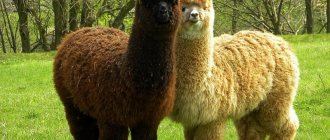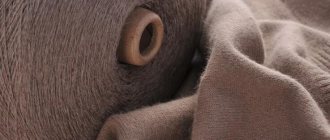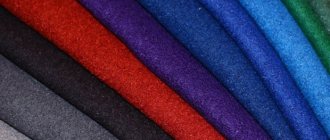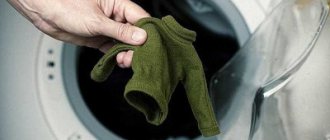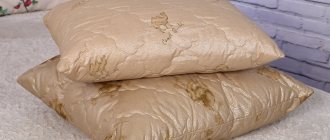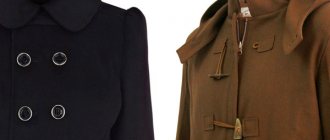Alpaca is a fabric for patchwork and interior decoration. Translated from the Indian language it means “dog”. To produce the fabric, they use the wool and skin of animals that live in the highlands of the Andes. Thanks to a special processing technology, the yarn does not fall into lumps and, accordingly, does not roll down. Alpaca is considered the warmest wool of the animal. Alpaca products are very soft and warm. The fabric drapes beautifully, and thanks to the high density of the fabric, you can sew any product.
The expensive plain or twill weave wool fabric was named after a domestic animal that belongs to the camelid family. Alpacas are bred in South America - in the Peruvian Andes. These beautiful and intelligent creatures were tamed by local residents several thousand years ago.
- In the distant past, their unique and high-quality wool even played the role of currency .
- However, later the Spaniards arrived in their habitat and preferred to raise sheep.
The alpaca returned to its former glory as recently as 1984, when these animals began to be transported from Chile to America. Today, Peru is considered the most famous and largest supplier of wool raw materials. This area has the most suitable conditions for alpaca breeding. The condition and smooth structure of the wool is influenced by the ambient temperature, nutrition with certain mountain herbs, processing technology and even air density.
- The number of tons of alpaca wool per year reaches about 4000. It is important that the animals are sheared only once every two years, so such a large amount of raw material sounds impressive.
Secrets of alpaca production
Alpacas are bred for the purpose of trimming their hair. Despite the fact that it is often impossible to shear these animals, you can get a maximum of three kilograms of wool from one adult alpaca per shearing. The blended fibers are hand-sorted to ensure the finished fiber is of incomparable quality.
After sorting, the threads go through a cleaning stage: craftsmen remove grains of sand, dirt and grass. Next, the spinning process itself begins. Then the finished fabric needs to be washed to remove previously unnoticed debris or greasy stains. The next stage is considered optional: the fabric can be dyed with high-quality dyes or left in its natural form.
- Dyed fabrics may fade when washed , but it all depends on the type and quality of dyes.
Composition, properties, characteristics
Warm, expensive and pleasant to the touch, the fabric combines the softness of llama wool and the healing properties of camel hair. Alpaca wool fibers are suitable for a wide range of weavings as they do not retain their shape. Alpaca is not usually dyed as the wool is available in 22 luxurious natural dyes from white, pearl to brown, coffee and deep black.
These woolen fabrics are stain-resistant, do not pill, do not lose shape, do not stretch or wrinkle. In addition, they can be used for sewing products for allergy sufferers: the fabrics do not cause dangerous allergic reactions. It is comfortable to wear clothes made from alpaca wool in both hot and cold weather. The fabric adapts perfectly to any weather conditions.
- However, for many, the price of this wool may seem too high, which makes this fabric inaccessible to ordinary people.
How does alpaca wool differ from llama wool and from sheep wool?
The main differences between alpaca wool and sheep wool :
- It is seven times more warm than sheep's wool and three times more durable.
- It has extraordinary lightness, but it is more difficult to process than sheep.
- Alpaca wool does not absorb moisture as much and also dries faster.
- At the same time, yarn made from sheep wool fibers is more durable.
Difference between alpaca and llama :
- The first one is much thicker and also longer. Alpacas have hair that grows from their head to their hooves.
- Llama wool is coarser, while alpaca wool is soft and delicate.
- One adult alpaca produces much more wool than a llama.
Alpaca
A significant quality of alpaca wool is its low allergenicity compared to the wool of other animals. Alpaca wool has all the qualities of camel wool and in some ways surpasses it.
Even camels of different species and breeds have wool of approximately the same quality and length of hairs; the difference is mainly only in the amount of fluff. The highest fluff content is found in Mongolian double-humped bactrians. Alpacas, depending on the type of animal, have completely different wool, both in hair length and color. Moreover, alpaca wool has its own natural color, which is much stronger than any artificial one. There are two types of alpacas. The most common type is called Huacaya. They have soft, fine fur similar to ivy, which makes them look like children's teddy bears. The three most common colors among alpacas are colors, although the most versatile is white, which can be dyed into other colors.
The second, rarer species is the Suri alpaca. Suri's fur is long, curls into curls as it grows, and often hangs in braids to the ground. Suri wool is considered the highest quality and most valuable.
Alpaca wool has amazing properties. Wool fibers are not solid, but hollow inside. This makes the wool exceptionally light and highly insulating, unlike any other animal. Alpaca wool is not uniform in structure. The outer hair is coarser, its thickness is from 25 to 100 microns. The inner layer consists of soft hair and downy undercoat, the thickness of which is 17-21 microns. Alpaca wool is very warm. This is a wonderful insulator that constantly maintains body temperature. Thanks to the properties of its wool, alpaca feels comfortable in both heat and cold. Therefore, like a camel, he is neither hot nor cold.
You can find out who alpacas are, how and where they are raised from the article Alpaca. And how they are cut, how the wool is obtained from them, what it looks like and what kind of yarn they make, we suggest you look at the photo gallery below. Alpaca yarn is considered one of the best in the world due to its lightness and ability to retain heat. The dyes for this yarn are only natural, no chemicals.
Alpaca wool supplied from Peru is considered one of the best in the world for its quality.
It is in Peru that alpacas are bred most often. There they graze in free meadows and are collected into pens only during shearing. The appearance of these alpacas, covered with long, thick hair, suggests that they will soon be sheared.
Shearing day is a special day for the entire village, although not only the residents, but also all the alpacas get excited and watch as their relatives are taken away for shearing.
Shearing an alpaca is a rather complicated process and in order not to spoil the expensive wool, it is trusted only to experienced shearers, who have usually sheared sheep before.
Alpaca has very valuable wool. The so-called royal alpaca has hair diameters of no more than 19 microns. She is the most expensive and only top shearers trust the haircut of such individuals.
Thick, soft and pliable alpaca wool gives the imagination to experienced shearers who want to show off their art.
An alpaca scarf is a great gift for a man for the New Year. This gift will last for many years and look like new.
Alpaca outerwear, be it a coat, cape or jacket, will never go out of fashion.
Alpaca wool in Russia is not yet available to everyone, but given that alpaca has begun to be bred in Russia, it is possible that in a few years, domestically produced yarn will appear.
Alpaca shearing
Alpaco clothes
Hairstyle with beard
Alpaca yarn
Types of alpaca fabric
There are two generally accepted ways to vary alpaca wool, thanks to which you can easily choose the fabric you need for your purposes. The first of them is based on the type of alpaca, and the second indicator is based on the thickness of the fiber.
Depending on the breed of animal
The difference between the fabrics is obvious depending on the alpaca breed. Suri and Huakaya are considered the most popular and in demand. The first type of alpaca is quite rare, so the cost will be much higher. This wool is considered the best in the whole world.
By fiber thickness
Alpaca is distinguished depending on the size of the fiber:
- The Royal Alpaca is considered the finest. Its fibers are 19 microns thick.
- Baby Alpaca. Fiber diameter is approximately 22.5 microns. It is considered one of the highest quality.
- Very soft. This fabric is made from fibers 25.5 microns thick.
- Adult alpaca. Fiber diameter – 32 microns.
Premium wool - what products are made from alpaca
Particular attention is paid to sewing alpaca coats. Lightweight, wear-resistant elite fabric is suitable for both warm winter and cooler demi-season models. Not only does it retain heat well, but it is also not afraid of bad weather conditions. It will delight you with excellent condition both on the front and back for many years!
- The silky threads of alpaca wool are also loved to create cozy sweaters or jumpers.
Determining the quality level of the material
The quality of wool is difficult to determine by eye to a person far from the world of the textile industry. However, the authenticity and high level of production of the canvas can still be indicated due to the following factors:
Buy fabric or yarn only from trusted suppliers. TISSURA has been collaborating with time-tested brands for many years. Such companies do not hide information and are ready to share it upon request, so if desired, you can track the full fabric production cycle from processing raw materials to creating the finished product.
- High price. Fabric made from 100% alpaca or blends with other elite wool fibers cannot be cheap if first-class raw materials, modern technologies and many years of experience of professionals in their field were used to create them.
You can distinguish it from a fake using a simple experiment. Take the alpaca thread and set it on fire; when it burns, it will smell like an animal, not something burning or resinous.
A product made from natural alpaca will not be too hot or uncomfortable. This fabric does not create a greenhouse effect, unlike fakes made from other materials.
Types of alpaca
These animals are sometimes confused with llamas, which can often be found in zoos. However, alpaca belongs to a separate, rather rare species, which, in turn, is divided into separate subspecies.
The most common breed is the Huacaya, which resembles a long-legged, long-necked bear cub.
It is these animals that provide 95% of the alpaca yarn market. A much rarer variety is the suri, whose total population is about 120 thousand heads, and their wool is valued twice as much as the huacaya wool. Suri yarn and fabric are very rare and expensive because world-class designers, primarily Italian, work with them, so they are not produced in large quantities.
Animals are sheared once a year, obtaining no more than 3.5 kg of valuable fiber.
Fleece consists of fibers that are twisted or bent only at the ends, the thickness of which is comparable to the thickness of cashmere fluff and is no more than 25 microns. This wool does not contain guard hairs, and its smooth fibers lack lanolin, making it not damaged by dust mites and resistant to moths.
Alpaca has the following unique properties:
- softness and uniformity;
- light shine, silky fiber structure and absence of a specific “sheep” smell;
- unique thermoregulatory properties that manifest themselves at both high and low temperatures;
- a wide range of natural color shades ranging from snow-white to deep black;
- strength, durability, resistance to creases and rolling;
- higher hypoallergenicity compared to sheep wool;
- water- and dirt-repellent properties - rain rolls down the fibers, practically without being absorbed.
Currently, the main production of alpaca is carried out on farms in both South America and the USA, so there is a tendency for the cost of fabric to decrease, and an alpaca coat is becoming an affordable luxury. However, the leader in the elite segment of the market continues to be the wool of animals grown in the highlands, mainly in Peru. The cost is significantly influenced by the quality of the raw materials, which is determined immediately after shearing. After cleaning, the wool is immediately sorted by color (there are 22 natural shades in total, including burgundy and silver) and by hair thickness (5 categories).
More valuable and fine, but also less in total output, is the wool of young animals, which is assigned the “baby” category, and the best of them is “suri baby”, the thickness of the long fibers of which does not exceed 25 microns . Alpaca suri is produced individually, and its main consumer is Italy and Italian high fashion brands.
Pros and cons of fabric
The obvious advantages of wool fabric are:
- Lightness and subtlety.
- High breathability, which is characteristic of all natural fabrics.
- Hypoallergenic. A suitable option for allergy sufferers.
- Excellent thermoregulation. Suitable for both cold and warm seasons. Alpaca products are never too hot or too cold. The body in such clothes is always comfortable and comfortable.
- It is considered the warmest wool fabric. At the same time, as mentioned above, you will not sweat in clothes made from this wool, because alpaca does not create a greenhouse effect.
- Does not accumulate static electricity.
Not without its drawbacks:
- High price. This fact is not at all surprising, since transporting raw materials to other countries from South America is an expensive and time-consuming process. In addition, the processing of these raw materials is carried out by real professionals in their field.
- The fabric requires careful handling. Be sure to study the rules for caring for alpaca wool before performing any manipulations.
Where is this wool used?
This animal has been known to mankind for more than 6 thousand years.
Even the ancient Incas bred alpacas to produce valuable wool of unique color shades and the highest quality. Only representatives of the royal family and the ruling elite could afford such luxurious clothes. Now products made from alpaca are not the privilege of royal dynasties; anyone can afford to buy clothes or a blanket made from expensive fiber. Needlewomen often purchase yarn consisting of wool or blends containing alpaca.
The wool of these animals is used to produce the following products:
- sweaters, cardigans, jackets, pullovers;
- scarves, caps, hats;
- socks;
- coats and jackets;
- dresses, jackets, suits;
- carpets, rugs.
The raw material sheared from young animals is used for the production of costume and dress fabrics, and the fleece of mature animals is used for rugs and carpets.
Cost of fabric per meter
The TISSURA Fabric House presents original alpaca wool, delivered to us straight from Peru. Baby alpaca can be bought in our store from 7,300 rubles per meter. Italian Loro Piana coat fabric made from a mixture of alpaca and Australian merino wool is available at a price of 9,100 rubles per meter. The design of the latter is presented in several pastel shades: the Windsor check is available in grey, burgundy and beige. Read more detailed description on our website. The most expensive alpaca fabric costs 89,900 rubles per meter. This fabric from the Swiss brand Jacob Schlaepfer features elegant floral embroidery along the edges, imitating lace.
You can purchase fabrics online in an online store or in our Fabric House, where our experienced employees will advise you. Come visit us, because this way you can not only look, but also touch the canvases, evaluate in person the softness of their surface, check how dense they are, as well as how well the color, pattern or design meets your expectations. In TISSOURA you will find not only alpaca, but also other luxury wool fabrics from leading European brands: angora, vicuna, llama, cashmere and camel hair. For the lining, our staff will help you choose elegant silk options, both plain and printed, for example, striped.
Application
For many years, the unique features of this fabric have been appreciated by many people around the world. In the distant past, alpaca products were available only to a certain class, but today everyone can experience luxury, even though it is not cheap. Alpaca wool yarn is often used not only for making finished fabric, but also for needlework. Popular products that can be sewn from alpaca fabric:
- Outerwear: coats, jackets.
- Accessories: caps, scarves and hats.
- Casual clothing: socks, dresses, sweaters, tracksuits. Particularly convenient are double-sided products that can be turned inside out and worn that way.
- Interior items, a set of home textiles: rugs, bedspreads and carpets. For this category of items, manufacturers often resort to wool raw materials obtained from old alpacas.
The high cost of this wonderful material is justified by the unsurpassed characteristics of natural raw materials. Excellent thermoregulation, durability and excellent aesthetic qualities make clothing made from alpaca wool truly versatile and suitable for wearing all year round.
Interesting Facts
- Alpaca fiber, often mistakenly called alpaca wool, is very warm!
- Alpaca stripes examined under a microscope reveal tiny air pockets through the alpaca fiber. These air pockets are what make alpaca fiber such a great insulator, making alpaca fiber clothing warm and very light.
- Vegetable alpaca contains natural oils, fat or lanolin, so don't worry about clothing made from alpaca fiber having an unpleasant odor that will need to be masked.
- Alpaca fiber is stronger than Merino wool; therefore, it is more resistant to abrasion.
- Alpaca fibers are extremely durable. It can be mixed and painted with any color without losing its natural shine.
- It is compatible with wool or worsted systems, so garments do not need to be made entirely from alpaca fiber. Additionally, because the fibers are so strong, they are waterproof and can withstand solar radiation.
- First of all, Alpaca fibers have a wonderful silky sheen, very attractive to the eye, making it a high commodity in the clothing industry.
- Alpacas are naturally neat when living together. They even all use the same place on earth, like their shared bathroom!
- Ancient Incan societies used alpacas as their means of survival. Everything they made, from clothing, to roofs, to bridges, was made from Alpaca fiber. Even their mode of currency was Alpaca cloth!
- There are two main types of alpaca fiber; Huacaya alpaca has a natural “crimp,” or “crumb,” in the fiber. This natural wave in alpaca fiber creates a yarn that retains its shape over time. Suri-alpaca fleece is known for its natural shine and shine. Suri Alpaca fiber is something that is widely used in high end yarn manufacturing as it features a wonderful way the shine can interact with light.
Video
Recommendations for care and washing, protection against moths
Rules to follow if you want to extend the life of your favorite woolen product:
Alpaca requires care not only in care, but also in the method of storage. Wool made from such fibers does not like mothballs: if you want to get rid of moths, turn to alternative methods of protection of natural plant origin - lavender or cedar. Do not use synthetic repellents.
- Wash. Before any manipulations, be sure to read the manufacturer's recommendations. Depending on the type of item and its density, you should wash the item in a washing machine or only by hand. Very thin things that become completely thin at the slightest stretch should never be trusted in a machine. Alpaca is washed in cold water (about 30 degrees) with detergents that are specifically designed for this material. Avoid using harsh substances like bleach. You can use dry cleaning services. We recommend washing the item every seven to eight wears to prevent rapid wear.
- Drying. You should not squeeze them, it is better to let the water drain on its own by hanging the product horizontally. Dry away from heating devices and scorching sun. Remember to return the item to its original shape when drying so that the fabric does not become deformed in the process. You can return the pile to a presentable appearance using a brush or a not very hard sponge.
- Ironing. Carefully, on a delicate setting, iron through a damp cloth.


